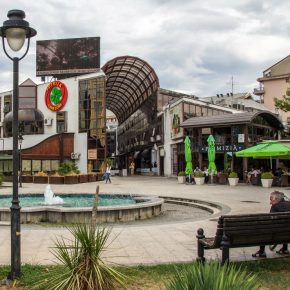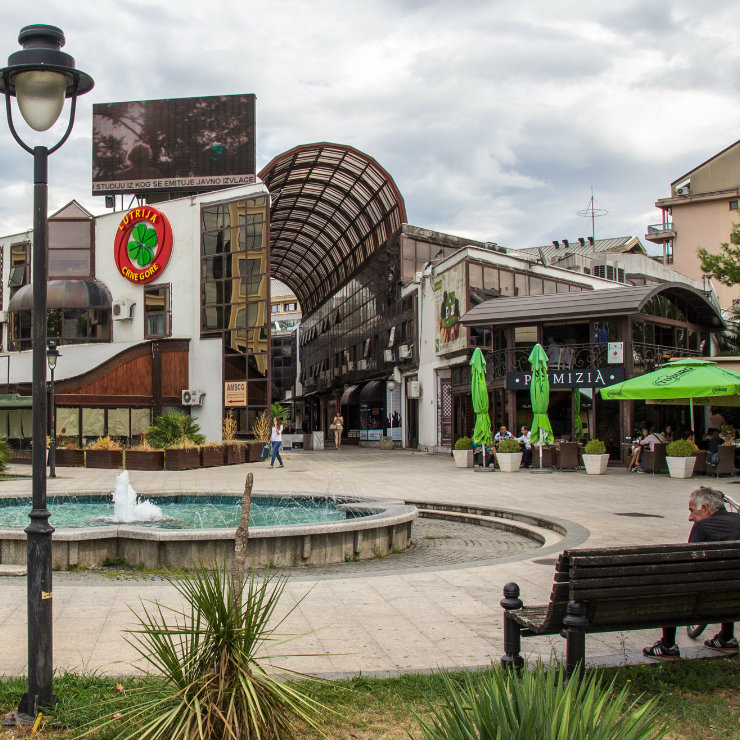
Podgorica, Montenegro (Alex Alishevskikh, CC BY-SA)
The overall state debt in the end of first four months of 2018 is EUR2,66bn or 60,6 per cent of the country’s GDP. In comparison to the end of 2017, this is EUR37,4m more. Foreign debt is EUR2,196bn, while domestic one is EUR469,2m. Deposits in the end of first four months of 2018 are EUR72,4m or 1,6 per cent of GDP.
This was surprising for the Montenegrin government, as Podgorica introduced large austerity measures. It has increased the VAT to 21 per cent, undertook more excise taxes, everything to curb the public debt. In April 2018, the Montenegrin government borrowed EUR500m through the Eurobonds but also made a debt of another EUR250m with the World Bank guarantees. Overall, the government added EUR825m of debt since the beginning of the year and within the rebalance of this year’s budget it is expected to borrow another EUR940m.
These mounting debts give a negative picture of Montenegro after political successes in 2017. Then Montenegro entered NATO, which is important from security viewpoint but also guarantees better economic development through investments and international economic cooperation. In accession negotiations with the EU, Podgorica opened 30 and finished three accession negotiation chapters. It is also involved in the Regional Economic Action Plan for the Western Balkans, within the CEFTA jurisdictional framework. The strategic development objective of Montenegro defined in the Economic Reform Program is a sustainable and inclusive economic growth that will contribute to reducing the country’s development gap vis-à-vis the EU average and increasing the quality of life of all its citizens. By 2017, the GDP per capita in current prices is estimated at around EUR6,770, while the parity of purchasing power is currently at 42 per cent of the EU average. At the same time, it points to the fact that Montenegro needs the real economic growth rate in the coming period, from about 4 per cent per annum to make GDP per capita grow faster than in the EU and in consequence, the standard of living is getting closer to the standard of developed countries.
The local political scene thinks every new indebtment is few steps away from the EU membership. Current opposition questions the government’s economic policy and the new president Milo Đukanović’s desires to „come back“ to Europe soon. This critique is tied to the new Montenegrin obligations in its approach to the Maastricht criteria and especially the definition that forbids the public debt over 60 per cent of GDP. The Montenegrin problem is not mounting debts in order to invest in capital projects and development; this money is mostly used for government spending and return of credits and interests. Additionally, Montenegro has systematic economic problems including an overall weak economy, huge shadow economz, oversized administration, fiscal indiscipline of companies and governmental preferences, and illegal protectionism of certain corporations and entrepreneurs.
One of the credit lines is closed after the MIDAS 2 project came to end, where the creditor was the International Bank for Reconstruction and Development (IBRD). The project was worth EUR30m, while additional project of EUR26,55m was for the advancement of tax administration. Export Development Canada gave a credit of EUR26,55m for Ministry of Defense’s three new helicopters. Another EUR8,2m was borrowed for infrastructural projects, including the Bar – Boljare motorway. First part of this motorway, Smokovac – Mateševo, was paid with a credit agreed with the Chinese Exim bank. Within the first four months the government paid debts of EUR99,75m: EUR82,57m was paid for the residual debts, including the EUR74,53m for re-financing the treasury bills, while EUR17,18m went for the non-residual debts.
Indeed, the European Commission suggested the Montenegrin government to gradually reduce public spending on salaries and pensions as a share of GDP; ensure the availability of adequate financial resources for the implementation of new legal measures; enhance tax revenue and analyse tax exemptions with a target to their further decline; and to adopt measures to facilitate debt servicing by leveraging local debt markets, extending maturity and improving privatization program. Fiscal policy of Montenegro is aimed at intensifying investment in infrastructure and optimizing current consumption. The goal in the period 2018-2020 is the consolidation of public finances in order to create conditions for reducing the public spending deficit and establishing a declining trend of public debt growth.
Until that happens, Montenegro seeks the investors in infrastructure, tourism and energy. The United Arab Emirates (UAE) is the largest foreign direct investor in Montenegro, investing EUR92,8m in the first 11 months of 2017, mostly investing in companies and banks, according to the Montenegrin Central Bank (CBCG). The money that came from the Emirates in 2017 accounts for almost one-sixth of total foreign investments, worth EUR538,3m. One of the major investments from the UAE was the construction of Capital Plaza in Podgorica, where EUR140m was invested, and investors from Emirates have invested in the last two years at the nautical settlement of Porto Montenegro in Tivat. They are equally interested in buying and constructing the wind power plants. Otherwise, the inflow of FDI increased by 13,4 per cent. The second place, after Emirates, goes to Russia with EUR54,7m worth investments, while the third is Italy with EUR 7,5m. The fourth place takes Azerbaijan, which has invested more than EUR45m, and in fifth place is Germany with EUR36,3m. Almost 40 per cent of all the investments goes in the tourism sector.
But to really decrease the public debt, Montenegro needs to start comprehensive economic reforms, including strengthening fiscal stability and sustainability of the economy; preservation of a predictable and competitive tax system; strengthening physical infrastructure; systematic reduction of the informal economy; strengthening support for small and medium-sized enterprises with the diversification of production and export bases; human resource development and increased labor market flexibility; strengthening social inclusion; further strengthening the rule of law.
The government has already implemented a package of fiscal consolidators for 2017, which has contributed to a 3 per cent drop in budget deficit which is a benchmark suggested by the European Commission and shows an optimistic trend.
Vedran Obućina is an analyst and a journalist specializing in the Croatian and Middle East domestic and foreign affairs. He is the Secretary of the Society for Mediterranean Studies at the University of Rijeka and a Foreign Affairs Analyst at The Atlantic Post.


